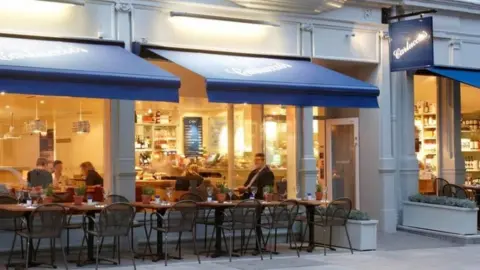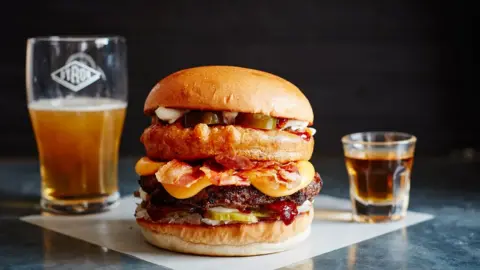Carluccio's is latest restaurant chain to feel the heat
 Carluccio
CarluccioOne in three of the UK's top 100 restaurant groups are not making a profit, according to new research into the struggling casual dining sector.
Italian chain Carluccio's has joined a lengthening list of chains losing the battle against higher costs and increased competition.
The deli to dining brand has called in accountants KPMG to advise on possible strategies.
Prezzo, Jamie's Italian, Byron and others have already announced closures.
A boom in casual dining a few years ago, has given way to dog-eat-dog competition as the now crowded sector faces higher costs and faltering consumer appetites.
"There is little respite on the horizon" according to Peter Kubik, partner in the London office of UHY Hacker Young which conducted the research.
UHY Hacker Young says last year 20 of the top 100 restaurant groups were loss-making. This year it is 35.
Which chains are struggling?
Carluccio's and KPMG are tight-lipped over exactly what options are under discussion.
But it's another sign that the old certainty - you can always make dough from selling pizza - no longer holds true.
Other Italian-style eateries are already facing the music: Prezzo is closing 94 outlets, Jamie's Italian is shutting 12 branches and Strada 11.
 Getty Images
Getty ImagesWith so many Italians on the High Street from Pizza Express and Zizzi to small independents, this part of the market is saturated, says Stefan Chomka, editor of Restaurant magazine. And the same goes for mid-market burger chains.
"Every town pretty much has a decent place to get a burger whereas ten years ago they didn't and so they've experienced some of the fall out from that," he says. Byron is in the process of restructuring and is likely to close 20 of its 67 branches.
Who is still succeeding?
"Wagamama does pretty well," says Mr Chomka. "Likewise Nando's is a fascinating success story."
Both chains, he says face less direct competition from similar brands.
"[Nando's] goes up against the KFC's of this world but its not a KFC. It's a proper sit down dining experience. It's great for young people. So it's doing really well."
Another that's bucking the trend he says is Franco Manca. It's Italian, but it is cheaper than Pizza Express et al and also appeals to a younger crowd.
"It has grown phenomenally in the last three or four years as people have moved from larger chains towards some of the smaller chains," says Mr Chomka.
Why are times so tough?
There are a number of things says Peter Kubik at UHY Hacker Young that are preventing the numbers adding up for restaurant chains.
The fall in sterling since the referendum vote has pushed up the cost of any imported ingredients whether that's mozzarella or meat, olives or avocado. And staff pay is going up too.
"The government has ratcheted up costs with a series of above-inflation rises in the minimum wage, and we are just weeks away from another 4.4% rise in April," says Mr Kubik. "That will be tough for a lot of restaurants to absorb."
Mr Kubik says "Brexit hanging over consumers like a dark cloud" means people are more reluctant to splash out.
 Mowie Kay
Mowie KayWill Wright, KPMG's restructuring partner responsible for Byron's recent deal with its creditors, adds in rising business rates and the burden of debt being born by a lot of the chains - the result of a flurry in merger and acquisition activity that has left some stuck with the wrong sites in the wrong areas.
"As restructuring practice we've never been as busy as we have been in last few months in this sector," he says.
Are we eating out less?
There are certain fashionable city centre places, where if you turn up at the wrong time you can still end up queuing for a table. For example cafes offering highly 'Instagramable' weekend brunches.
There is still a buoyant market for places that get the offer right, according to Deloitte.
But consumer spending power, squeezed by low wage growth and higher inflation, means consumers are reining in discretionary leisure spending in general, and that includes spending less at restaurants. Some are replacing it with home delivered meals, or ready-meals like Marks and Spencer's successful Dine In for Two for £10.
Some restaurants have responded with ever more aggressive discounting; Deloitte found 38% of visits involve a deal or special offer. But of course, in terms of profitability that only makes things worse.
How much will change?
Sarah Humphreys, lead partner for casual dining at Deloitte, thinks the current spate of closures is "a blip" and that before long we'll be back on the long term trend of a booming market for meals out.
"If you look forward ten years... we will be eating out more often," she says.
But the current squeeze means in the meantime we're likely to notice changes on the High Street this year, says Mr Wright at KPMG, whether just because the less profitable branches are gone or whether whole chains end up disappearing.
"It's a very fast moving sector. New concepts are what it's all about. Businesses need to stay very relevant and to do that they need to spend money on their sites to keep them fresh," he says.
Ms Humphreys and the team at Deloitte think reduced margins now will focus minds on improving productivity and investing in new technology like pre-ordering, mobile payments and customisable menus that appeal to younger customers.
The future she says will be all about giving customers a better experience, and points to concept restaurants like Bounce which offers meals and ping-pong side-by-side; or food alongside crazy golf, or music.
"It's about making it an experience: something with drama and pizzazz," she says.